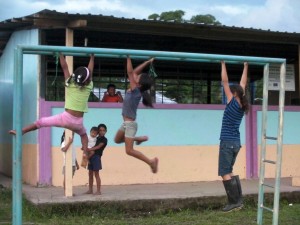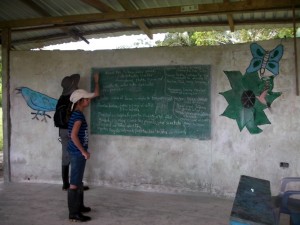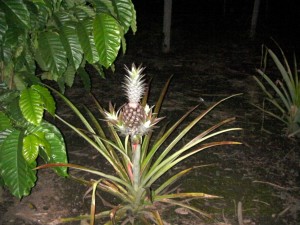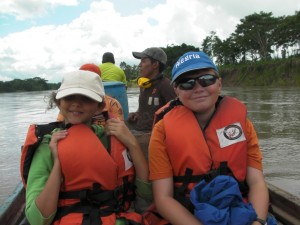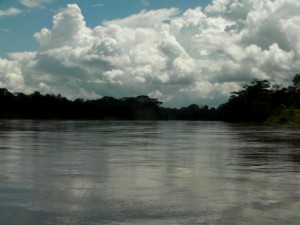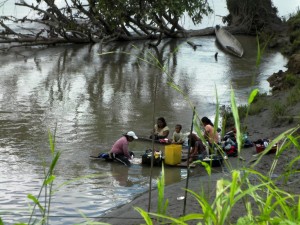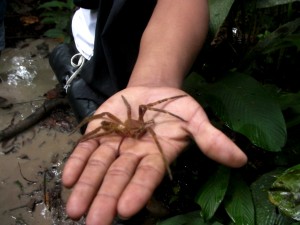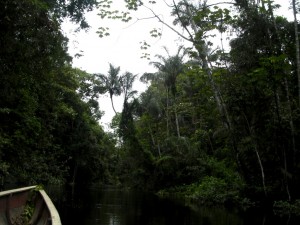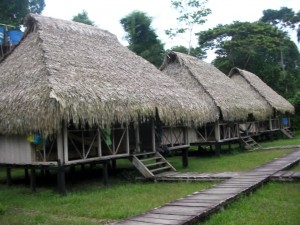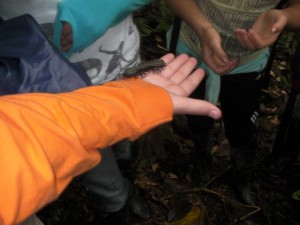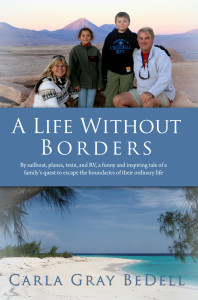The next few days passed quickly. We were constantly out exploring. By the end of our stay we had spotted seven species of monkeys including the large and loud howler monkeys whose call sounds like the winds of a storm, the tiny Titi monkeys, the adorable Squirrel monkeys, the elusive Spider monkeys hiding high in the treetops, a family of Woolly monkeys with their long thick tails, the playful Capuchin monkeys, the funny Tamarin monkeys and the noisy Night monkeys. We heard the monkeys before we saw them, making it difficult to capture them with a camera, so we just watched and enjoyed the show. While the monkeys were a highlight for us, I think the kids were most excited about seeing the Sloth bear that was hanging on the side of a tree. Paula and Claudio were very excited about that too. I couldn’t keep track of all the birds we saw including white billed toucans, parrots, macaws, kingfishers, beautiful, electric blue butterflies and an interesting bird called the Hoatzin, also known as the “Stinking Turkey”. We didn’t see piranhas, though we tried to fish for them, but we saw something much better. Pink River Dolphins!!!!
As we came to the spot in the river where they sometimes saw the dolphins, Paula told us we needed to stay quiet or we would scare the dolphins. She said they were very shy. Claudio tried calling them by speaking river dolphin but nothing happened. It looked like this was going to be a bust. This “being quiet” didn’t sound right to us. We may not be indigenous guides, but we know dolphins. We speak dolphin. The kids and I started yelling “Dolphins” and whistling, making noise and sure enough, within a few minutes two river dolphins surfaced near the boat. We had the entire boat calling and more dolphins surfaced to check us out. It’s universal. Dolphins love to see people, especially kids.
Late one afternoon we visited Claudio’s Quichuan village. As we arrived some men were involved in an intense volleyball game. Yes, despite the fact that people of Ecuador are not much taller than Tessa, volleyball is a HUGE sport here. They play it everywhere and this village, though poor, had a nice volleyball court. Who would have guessed? Claudio immediately joined in the game while Paula showed us around. The village was quiet and small. A lot of the younger crowd had moved into the city to find work. Teen aged pregnancies were a big problem here. There was a local school, very small that served kids through what we would think of as middle school. After that, they needed to go to Lago Agrio or another larger town if they wanted to finish school.
That was out of the question for most families as the children needed to enter the work force or the girls became pregnant. A sad fact about Ecuador is the lack of education for poor children. In Quito, school is supposedly mandatory, but we saw several children, selling gum or candy or whatever, in the city. Other towns we saw the same. Ecuador is very poor and everyone in the family needs to work.
One of the things the village did for money was to make and sell crafts. A few of the younger children showed us the turtle sanctuary the village was involved with. The villagers gathered the turtle eggs, raised the turtles in a protective pen inside the village and when the turtles were larger they were released back into the river. Paula told us that at that moment there were three thousand baby turtles in the one of the two pens. Amazing!
While Tessa played on the playground with the local children, Paula finished the tour of the village. We had one more stop before heading back. Paula wanted to show us a small plantation not too far away. An added bonus was the family who lived there had a pet monkey. It was dark by the time we reached the plantation. This didn’t deter Paula. By flashlight she showed us the coffee trees, coco trees, pineapples and rice fields. Then we went into the house to see the monkey. The house was built up on stilts, presumably for flooding, and was an open floor plan. There were no bedrooms, the 5 small children shared a bed in one corner and I’m not sure where the parents slept. It was clean and neat and everything had its place. The pet monkey, which the owners found as a baby when they cut down a tree, was hiding in the rafters when we came in. It was dark in the house, I didn’t see any signs of electricity. Everything was by candlelight. I was so intent on getting a picture of the monkey that I walked through the room, in my big rubber boots and kicked over this smoking thing that I assume was burning to get rid of mosquitoes. It was smoldering on the floor, leaking whatever flammable liquid was in it. The family just laughed and got it righted, but I couldn’t believe it. I could have easily set the house on fire, which in turn would have set the Amazon on fire. Can you imagine? You are sitting in your living room, minding your own business, when some tourists stop by, bumble through your living room, and accidently set your house and business on fire. Unbelievable!
The next day we headed back to civilization. Our 5 days 4 nights had passed too quickly. On the way, we again stopped at the family’s house (with the monkey) so our cook (who was going on vacation) could buy a live chicken. What would he need a live chicken for? We thought maybe he was going to cook it. When we arrived at the place we were to meet the van, an indigenous man came down the road toward us. By this time we were in the van waiting for the last of our luggage to be loaded. The man was dressed in a bright pink tunic and around his neck were beads, red and yellow feathers and flowers around his head. You could tell he wasn’t wearing a “costume”, this was the manner in which he dressed everyday. From both the way he carried himself and how Paula and the rest of the crew acted around him, it was obvious he was a man of importance. In his hand he carried a long machete. I wanted to get a picture but when he saw my camera he put up his hand and Paula and Alex moved to block him from our view. Our driver told me I wasn’t allowed to take his picture. We watched as he took the live chicken from our cook. He had the live chicken in one hand and the machete in the other and I got my camera ready, sure I was about to see some kind of shamanic moment. He saw me again start to raise my camera, don’t ask me how as I was inside the van. The look he gave me was one that told me he knew exactly what I was thinking and I’d better not do it. I felt pretty sure he put some kind of curse on me. (Case in point, I broke my arm a few days later. Coincidence or shaman?) I put my camera down and decided it wasn’t worth it.
Everyone in the van was curious as to what was going on but the crew did a good job of blocking our view. Out loud I asked, “Is he a Shaman?”
Our driver answered, “Secoya.” I didn’t know what that meant. I said it again.
“Shaman?”
Again our driver replied, “No, Secoya.”
I waited a few minutes, not sure I had heard correctly. “Is he a Shaman?”
Again he repeated. “Secoya”.
Ok, are you ready for my comeback? “Is that Spanish for Shaman?”
Alright, here is the information. The man was one of the leaders of the Secoya tribe. The Secoyas live in the Amazon, on the land poisoned by Chevron Texaco. The tribe’s population, now around 500, has been decimated by the oil spills left by Texaco Chevron. In their lawsuit currently pending, they claim a high increase in cancer rates and aborted pregnancies.
The drive back was quiet. Everyone was pretty tired. Maria and Camilla were taking the bus, while we had tickets to fly from Lago Agrio back to Quito. Flying within Ecuador was cheap (not as cheap as the $1.00 per hour bus), and we again were given a discount for Tessa. Our flight on Tam airlines was great. The plane seemed new and spacious. At one point I looked out the window and my jaw literally dropped. We were flying directly over a volcano!!! I yelled for Dan, Tessa and Tristan to hurry and look out the window. We thought it was the Volcano Antisana. I could see the center, which was a deep, rich, rust brown color, encircled by snow and ice. I kept saying to the kids, “It’s a volcano! We’re flying over a volcano!” Unbelievable. It was one of the most incredible sights I had ever seen. Little did I know I would be saying that over and over again in amazing Ecuador.

